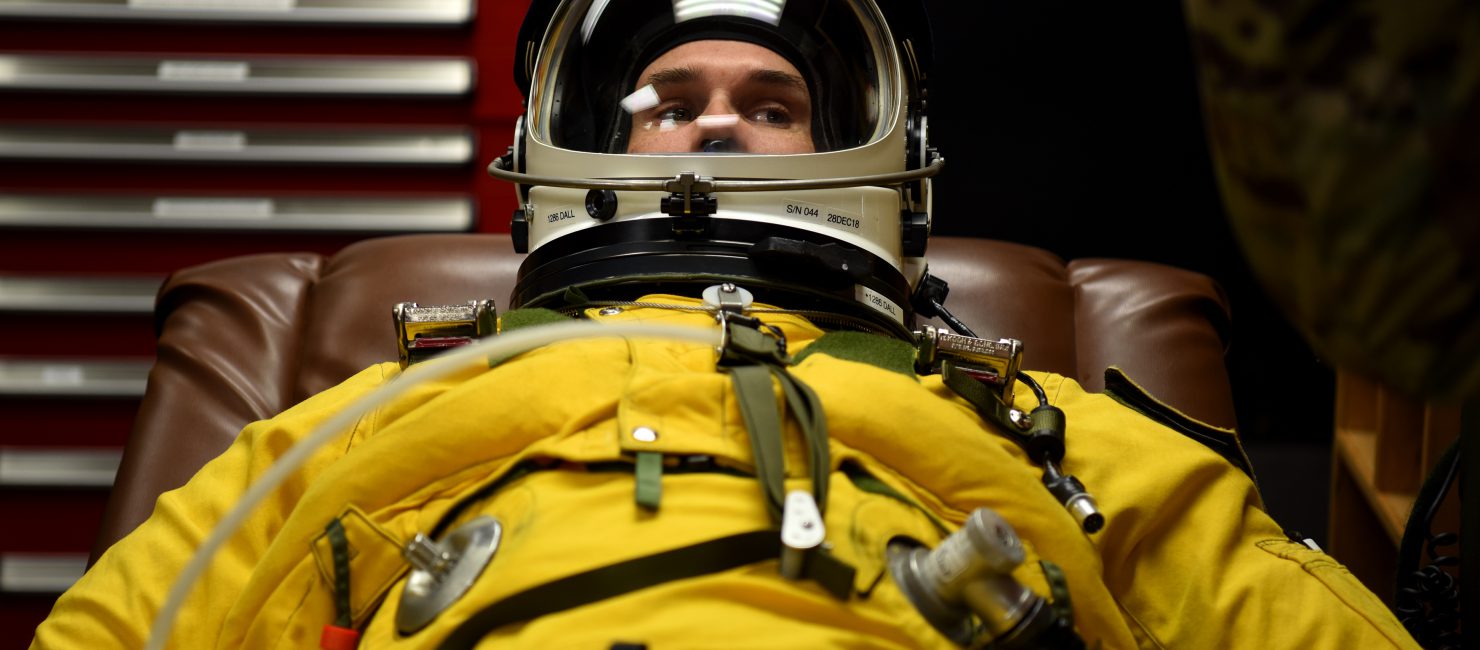U-2 Dragon Lady Pre-Flight Prep: Full-Pressure Suit With Video

One of the most indelible marks that Lockheed Martin’s Skunk Works division, led by engineering legend Chad “Kelly” Johnson, placed on aviation history occurred on July, 29, 1955 when the U-2 Dragon Lady flew for the first time. The high recon, single-seat, single-engine surveillance aircraft takes electronic measurements, signals and a variety of advanced images from above 70,000 feet in the air. At that altitude, the aircraft is near space and flights last beyond 10 hours in some cases. The demand placed on pilots is stout.
Because of these factors, allies and enemies around the globe know all about the U-2. It’s important role in the Cold War as well as the aircraft’s rarity give it legendary status. Many consider U-2 pilots the most talented in the world. However, the elite in any realm usually have to work around the biggest obstacles – and it’s no different in the U-2 cockpit. The U.S. Air Force engineers create solutions to myriad issues that the long, high missions implant on the human body. Much of the U-2s success as a plane relies on the extensive scientific and mathematical work surrounding the pilot. For instance, because the plane pushes the boundaries of the ozone layer, pilots wear what is essentially a space suit.
U-2 Dragon Lady Pilot Suit History
As the video below shows you in detail, the pre-flight preparations are extensive. When the U-2 program began flying in 1955, the pilots wore a partial-pressure suit. It wasn’t much more than a fire-retardant jumpsuit with a few bells and whistles on the extremities and helmet. David Clark Company designed the first partial-pressure suit, labeled the MC-3. Although a major advancement from prior partial-pressure suits, it wasn’t enough to fully protect every pilot while also getting the most of the U-2’s capabilities.
Lockheed Martin upgraded the airframe in the mid 1960s, and cockpit space in the U-2R increased. Officials from Lockheed Martin, CIA, the Air Force, David Clark Company and Firewel met to discuss how to reach the full potential of the U-2. In 1967, because of a larger cockpit, this coalition created the first full-pressure suit, called the S1010. It weighed 31 pounds and folded into a 2.7 cubic-foot box if necessary, excluding the helmet. All pilots wore the same size helmet because only one size existed (check out an in-depth look at the F-35 Lightning II’s helmet), but the suit was entirely customizable. However, it needed an improvement as time went on.
Upgrades
In the mid-1990s, engineers went back to the drawing board. This time they sought to create an advanced long-term solution. The product is the S1034. This suit took into effect all of the following: visibility, mobility, durability, maintainability, eating and drinking necessities, altitude protection, thermal protection, oxygen systems, dexterity, comfort and survival characteristics.
Engineers increased flexibility in the connection between suit and helmet, increasing visibility. The emergency evacuation harness received reinforcements. The helmet became lighter. Gore-Tex replaced the Neoprene in the U-2 suit’s bladder because Gore-Tex wicks away moisture. With some flights lasting half a day, pilots must urinate at some point. The Gore-Tex keeps the suit from damaging due to excess moisture. Adjustments to the weighted gloves created higher dexterity for the pilots. All in all, the S1034 full-pressure suit used today costs roughly $250,000.
Oxygen and the U-2 Pilot Suit
One thing that hasn’t changed much at all over the years is oxygen. Every pilot lies down to breath pure oxygen for at least an hour before the flight. Nitrogen bubbles form in the bloodstream because of the altitude if the cockpit/suit isn’t pressurized properly. The fallout from that is potentially disastrous, effecting the spinal cord and nervous system or even boiling the blood of the pilot – killing him/her. The best way to combat nitrogen rising in the blood as well as dissipate any nitrogen already in the blood is to breath pure oxygen. This is known as pre-breathing. It took place in the 1950s just like it takes place today.
“The partial suit was fitted and acted like a girdle,” Lt. Col. Tony Bevacqua, one of the first U-2 pilots, said in a story for the U.S. Air Force. “It was skin tight throughout and when you lost pressurization, the external hoses would enlarge and tighten the suit more. It did its job by preventing your blood from boiling, but it was very uncomfortable.”
U-2 Cockpit
After the pilot pre-breathes, the pilots’ suit hooks up to a portable oxygen system. The portable oxygen goes from the pre-breathing area to the cockpit of the U-2. The breathing cycle never breaks, it continues until the pilot is in the cockpit. Once inside the pressurized cockpit and flight suit, simple bodily acts become difficult. The process of swallowing is now hard, the pilots eat pureed food through a tube and drink sugary water to combat the effects of breathing pure oxygen. All of this is going on while the pilot is flying the hardest plane to fly, at the highest altitude on some of the most dangerous missions.
Landing a U-2 spy plane is not like landing any other aircraft. As you see towards the end of the video, the alignment and attitude must be just right or else the U-2 won’t land safely. While the U-2 lands, a chase car with a fellow U-2 pilot follows the U-2 at a high rate of speed in order to communicate alignment and attitude to the pilot landing the aircraft. The pilot basically lands the U-2 blind, every time. There’s a reason why U-2 pilots are elite.
Enjoy these beautiful images of the U-2 Dragon Lady!

